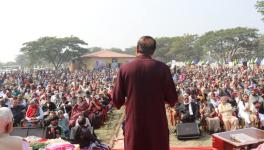Kolkata: 150-Year-Old Tramcars Heading for Extinction in ‘City of Joy’

Citizens protest the TMC government's decision to close down the iconic tram services in Kolkata.
Kolkata: Asia’s only electric tramway in operation in Kolkata, West Bengal, is set to disappear from the horizon soon, as the West Bengal government has decided to bring the curtains down on one of the city’s iconic landmarks.
Over time, the number of tram passengers, daily revenue and the number of staff have dwindled. “At 9 a.m, we enter our jail premises (workshops without any work) and until 5 p.m, our torture continues as we sit idly without any work,” Subir Basu, a former employee of the West Bengal Transport Corporation (WBTC) that runs the tramways, told NewsClick.
Several citizens have expressed serious concerns and nostalgia about the trams, which have been an integral part of the city’s cultural landscape having also featured in several films and books by eminent directors and authors from Bengal.
Politically, too, the decision has created ripples. Communist Party of India (Marxist) state secretary Mohd Salim rued that Kolkata wont “remain Kolkata, if Kolkata’s Howrah Bridge, Victoria memorial, the Maidan, its iconic Shahid Minar or the heritage tramways become extinct”.
“Kolkata is one of most polluted cities in the country. Cycling and tramways should be given more emphasis here, During the Left Front regime, while the Metro rail work was going on, a tourist route was planned to operate the tram on a truncated route. That was negated by the Left front government”, he told NewsClick.
It was the WBTC employees who worked for the future of the corporation by making a renovated, modern and light-weight tram with fibre body and transparent roofs to attune it to the present times as the rolling stocks rolled by on Kolkata roads. The Kolkata tramways, started in 1873. Earlier, these were horse-driven tram carts. In the early 20th century, these were electrified.
The tram service used to be well-networked with low fares providing an affordable ride for the common people. Many experts still argue that the trams could provide a sustainable solution to the city’s growing traffic and shrinking road space, while also being an alternative to vehicles operating with fossil fuel. However, with dedicated tramlines being used up by moving traffic and the lack of government support, tram services have been reduced to being a token.
There are reports that one by one, the tram depots and land of the workshops are being handed over to private entities. Over Rs 300 crore generated from the sale of tramway assets have been transferred to the government, while the organisation still faces a funds crunch.
During Left Fron rule, CPI(M) veteran Rajdeo Goala, who as a tramways worker in 1946 had helped thwart the Calcutta communal riots, was later appointed as Chairman of the corporation.
According to Basu and his fellow workers in WBTC, such as Tapas Adhikary, the golden period of Calcutta Tramways was between 1978 and 1987.
“In 1977-78, when the Left Front had just assumed power in the state, Mohd Amin, the then state Minister of Transport, had ordered 159 Jessop and Burn Standard body tram cars and invested Rs 43 crore for the betterment of tram services across the city,” they said.
The tramways had been at the centre of city transportation until the “neo-liberal regime” set in the country in the early 1990s, recounted Basu, adding that in 1993, within a night, the support of the Indian government to Calcutta Tramways was withdrawn, paving the way for a huge crisis.
When the British owners had withdrawn from Calcutta Tramways Company or CTC (later dissolved and taken over by WBTC), there were 13,500 employees in the company. In 1977-78, there were 7,500 employees in Calcutta Tramways. Then. in the 1990s, the total tramline in the city ran for 74 kilometres and 472 holding cars were in operation (cars in the hand of the company), of which 385 cars were in enroute condition.
On November 4, 1992, bus services were introduced under CTC with thousands of new recruitments. The next initiative for the tramways came in 2009 when new single-body trams were introduced and tramlines were planned to be extended to Rajarhat in North 24 Parganas.
However, after the change in regime in West Bengal in 2011, Calcutta Tramways faced its biggest crisis. In a single night, the Dharmatolla-Joka route was discontinued by the Trinamool-Congres- led government. The wages of 278 workers recruited as permanent workers within the period of 2008-2011 were discontinued leading to alleged suicides by two of the affected employees. With new recruitments closed, in 2011 there were 7,300 regular employees and 272 casual employees in the WBTC. The number has come down to 750 employees.
Right now, in the WBTC, there are 253 tramcars in operation, out of which 103 are in running condition, while roughly seven cars run on the routes every day. At present, the tramway operates on only two routes, compared with 25-28 routes in 2011.
In 2011, there were 62 km of serviceable line apart from depot land, which has reduced to only 17 km of line spread across three routes. Earlier, on the 62 km route, 225 tram cars used to run while now, 25 tram cars are running on the 17 km route. The number of passengers has also decreased from over 1 lakh in 2011 to only 8,000-9,000 passengers per day at present.
Earlier discussions to close down tramway services were thwarted by the positive public image they carry as an eco-friendly mode of transport. Roberto Andrea, an Australian tram conductor from Melbourne, too, had helped bring forth a positive image of tramways in India.
Last year, the CTC had observed its 150th anniversary amid protests by the Opposition against the government’s plan to withdraw tram services.
During the celebrations, West Bengal transport minister Snehasis Chakraborty had been invited by the Calcutta Tram Users Association (CTUA), a group of people advocating more tram services. Her had then said that the trams would run on “four or five routes” and “it would not be possible” to run them on all routes like before. He added that trams would remain a “heritage of the city”.
Speaking with NewsClick, Debasish Bhattacharya, president of CTUA, said the present government and minister are not interested in augmenting the services of Calcutta Tramways, often referred to as the ‘pride of the city’.
“The government was not keen to celebrate the 150th birth anniversary of Calcutta Tramways, but we participated in the programme in a big way to make it successful,” he said.
Get the latest reports & analysis with people's perspective on Protests, movements & deep analytical videos, discussions of the current affairs in your Telegram app. Subscribe to NewsClick's Telegram channel & get Real-Time updates on stories, as they get published on our website.
























